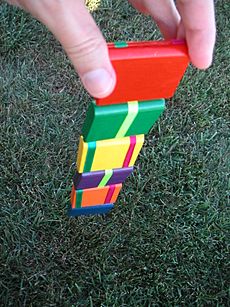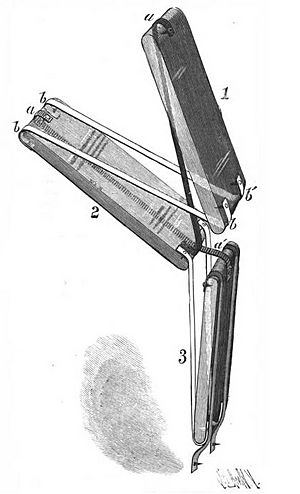Jacob's ladder (toy) facts for kids

A Jacob's Ladder is a fun, old-fashioned toy. It's also known as "magic tablets" or "Chinese blocks." This toy is made from several wooden blocks. These blocks are held together by ribbons or strings. When you hold one end of the ladder, the blocks seem to tumble down. They look like they are falling one after another.
This tumbling effect is actually a visual trick. The blocks don't really fall. Instead, each block flips over in a special way. This makes it look like they are moving downwards. The toy gets its name, Jacob's Ladder, from a story in the Bible. This story talks about a ladder that goes up to heaven. No one knows for sure where this toy first came from. But people have enjoyed playing with it for a very long time!
How Does the Toy Work?
The secret to the Jacob's Ladder is how the ribbons are woven together. They connect the wooden blocks in a clever way. This setup makes each block act like it's hinged to the next one. It can hinge at either of its two ends.
When you tilt the top block, it causes the next block to flip. This flip makes it look like the block is falling. But it's just turning over. This action then releases the next block, and it flips too. This chain reaction continues down the whole toy. It creates the amazing illusion of blocks cascading downwards. The blocks don't actually change their order. They just keep flipping and reversing their position.
Making a Jacob's Ladder
The way a Jacob's Ladder is built is quite smart. The ribbons are carefully interlaced between the wooden blocks. Imagine three blocks in a row. The first block has three ribbons attached to it. One ribbon goes over the top of the first block and under the second block. The other two ribbons go under the first block and over the second block.
This special weaving pattern is repeated for all the blocks. It allows them to move in a way that creates the illusion. The same kind of ribbon trick was also used in the 1980s toy called Rubik's Magic. But in that toy, plastic threads were used diagonally. This allowed the squares to hinge along two sides next to each other.
Where Did the Toy Come From?
The true beginning of the Jacob's Ladder toy is a bit of a mystery. Some stories say it came from China. Other tales suggest it was found in Tutankhamun's tomb in ancient Egypt. There's even a story that it was one of the few toys Puritans allowed children to play with on Sundays in early America. However, none of these stories have been proven.
Many different versions of the Jacob's Ladder have been invented and patented. For example, in the 1940s, someone patented a version that had a small space in one block. You could put a penny in it. Then, as the blocks flipped, the penny would seem to disappear and reappear!
A famous Japanese inventor named Hiraga Gennai (who lived from 1729 to 1779) also made a Jacob's Ladder. His version later became known as "Gennai's Wondrous Click-clack." This shows that people all over the world have been fascinated by this simple yet magical toy for centuries.


